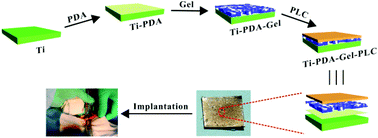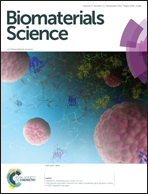The immobilization of antibiotic-loaded polymeric coatings on osteoarticular Ti implants for the prevention of bone infections
Abstract
Implant-associated infections in orthopaedic surgeries are very critical as they may hinder bone healing, cause implant failure and even progress to osteomyelitis. Drug-eluting implants for local delivery of antibiotics at surgical sites are thought to be promising in preventing infections. Herein, the antibiotic vancomycin was encapsulated in a poly(ethylene glycol) (PEG)-based hydrogel film that was covalently bound to Ti implants and subsequently covered by a PEG-poly(lactic-co-caprolactone) (PEG-PLC) membrane. Additionally, crosslinked starch (CSt) was mixed with the hydrogel because its porous microstructure is able to inhibit hydrogel swelling and thus slow down drug release. The release behavior could be regulated by the drug loading and the coating thickness. The vancomycin-loaded Ti implants showed no initial burst release, offering a sustained drug release for nearly 3 weeks in vitro and more than 4 weeks in vivo. In a rabbit model of S. aureus infection, the implants with a 4 mg vancomycin loading significantly reduced the inflammatory reaction and exhibited a good antimicrobial capability. The immobilization of the antibiotic-loaded polymeric coatings on orthopaedic implants can offer a sustainable drug release with no initial burst release and maintain an effective concentration for a longer time, so it is expected to be an effective strategy to treat and prevent local bone infections.



 Please wait while we load your content...
Please wait while we load your content...